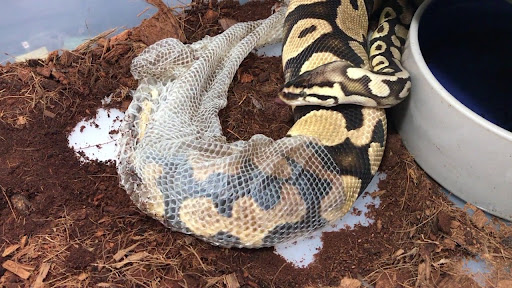Snakes are well-known for their peculiar method of skin renewal, which is known as shedding. However, shedding is not an uncommon occurrence. Most creatures gradually lose their outer shells.
We’ll go through the process of shedding in better detail further down.
A ball python’s initial shed occurs about two weeks after hatching, and they tend to shed every few weeks throughout the rest of their lives.
All snakes lose their outer layer of skin, and the process is crucial, even distressing at times. Therefore, it’s important to recognize that the shedding procedure often does not go well.
Ball Python Shedding Symptoms
A ball python will exhibit symptoms of beginning the shedding process before it sheds. A ball python may exhibit all of these symptoms or none at all before shedding.
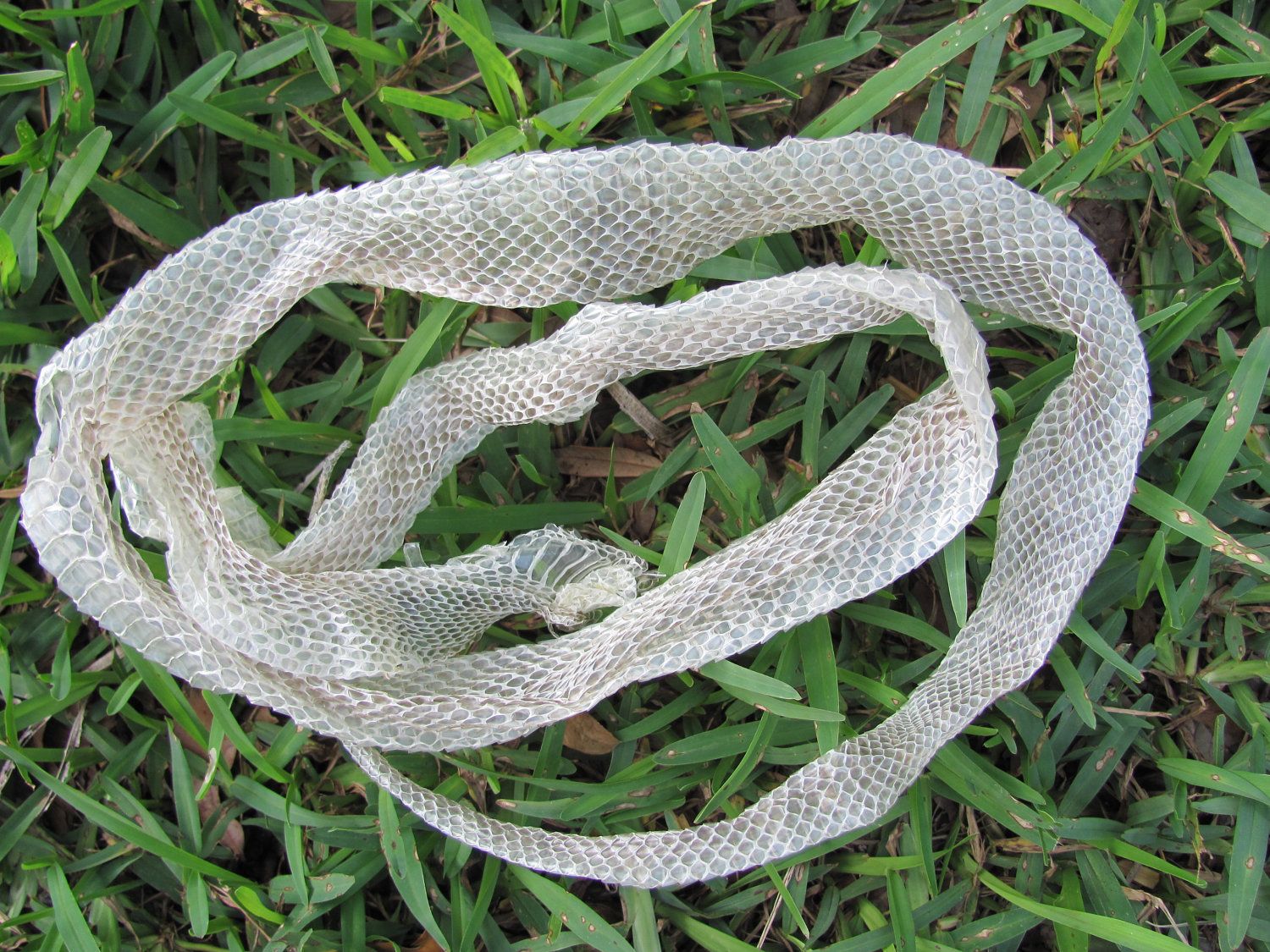
The essential thing to remember is that they will shed ultimately, even if it takes months.
Following are the first indications that your ball python is about to shed. If you see any or all of these symptoms, your ball python will shed in the next two weeks or fewer than that.
- Hunger Strike
Ball pythons have been observed going on hunger strikes for weeks or months. If a ball python refuses to eat, this is one of the first signals they are about to shed.
Even though this is typical behavior for a ball python, not all ball pythons skip meals when they are about to shed so keep an eye on the eating behavior to properly feed your ball python. Certain ball pythons will consume food no matter what, while others will refuse to eat at all.
For optimum results, avoid feeding your ball python if you notice any outward signs of them entering their shedding period since this might induce stress.
- Dull or Darkened Appearance
A ball python’s coloration becomes dull and faded, another clue that it is preparing to shed. Some morphs, particularly dark ones, will darken before shedding.
- Pink Tummy
When shedding, most ball pythons will have a pink tinge on the whites of their patterning. This is particularly apparent in high-white snakes, such as Piebald ball pythons.
Although ball pythons often have white bellies, the pink tinge is seen there.
- Skin that is Tight or Wrinkled
A ball python’s skin texture will alter, in addition to its colors changing before it sheds. You should notice wrinkles on your ball python’s skin, particularly near their curves. Their skin may feel and seem tighter as well.
- Hazy Vision
Ball pythons lose their skin all over their body, including their eyeballs. Their eyes will fog up and turn a dull blue hue when the skin on their eyes, also known as eye caps, begins to loosen.
Ball Python Shedding Process
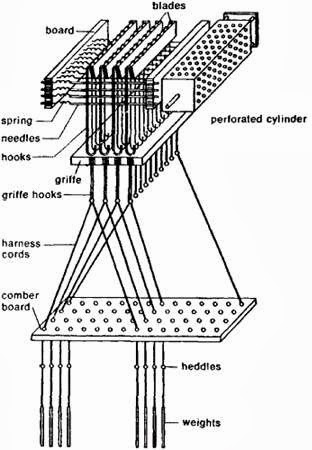
Ball pythons that shed go through several stages that may be identified by their appearance. These steps will require approximately 14 days to finish.
Every phase brings them closer to losing their skin, which only takes a few minutes.
- The Blue Phase
The blue stage is one of the most easily identified phases of a ball python’s shedding cycle. It portrays the stage at which a ball python’s eyes get cloudy and become blue.
It’s essential not to worry them at this period since they can’t see through the hazy covering over their eyes. Ball pythons tend to shun food during this period since they can’t see well enough and their tight skin becomes painful. Their hunger normally returns soon after they shed.
The blue phase will continue anywhere from a few days to a week, before transitioning to the following phase.
- The White Phase
The white phase of the ball python occurs just after the blue phase. The dullness and cloudy vision disappear during the white phase.
Throughout this time, the color of your ball python should return to normal. This phase is distinguished by the deeper coloration of your ball python.
During this stage, your ball python has produced oils beneath the upper layer of the skin that will contribute to the separation of the skin when it sheds.
Your ball python will shed a few days after the white process starts.
- The Last Phase
Ultimately, your ball python will begin rubbing its nose on anything to remove its skin.
It simply takes them a few minutes to totally remove their shed.
It is critical that you do not bother your ball python at this period, particularly because the procedure is unpleasant and requires a lot of energy.
Scale by scale, their top piece of skin will peel away from the front of their face.
The idea is for their shed to fall off in a single piece, but it doesn’t always happen. The shed may peel at times and come off in chunks.
Besides that, wait until your ball python has shed prior to actually handling or upsetting it for support.
Python Shedding Behavior
During the shedding period of your ball python, it will exhibit unusual behavior. As an example:
- Hunger Strike
Ball pythons are noted to go on hunger strikes, which are times of inactivity between meals. This is particularly true during their shedding seasons.
When it comes to food striking, each ball python is varied since some won’t have issues eating while they’re in any phase.
Most experts recommend avoiding even offering food if your ball python is in one of its shedding periods to prevent upsetting them out.
OR
- Gets Active Suddenly
Ball pythons sleep between 20 and 22 hours per day. Their most active periods are when they look for food and water or regulate their body temperature.
In the final stages of shedding, it will become more energetic than usual, moving about its enclosure.
They typically pick a nice area to begin shedding, which is especially evident when they begin rubbing their nose against everything.
Their nose scratching may appear aggressive, yet it is how they begin to lose their skin.
What Can You Do When Your Snake Sheds?
If your snake is in good condition and you’re taking good care of your ball python and its habitat, you shouldn’t have to do anything special during the shedding process.
However, excellent health and optimal husbandry circumstances are exceptional rather than the rule. This implies that snakes in captivity occasionally have problems with shedding.
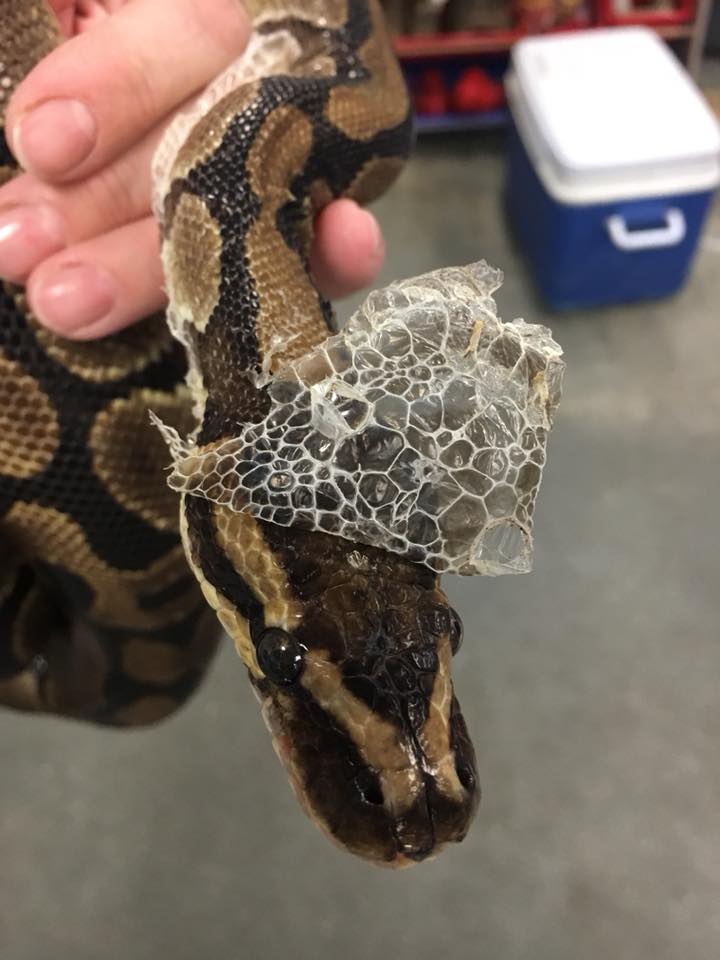
When your ball python is shedding, use the following basic strategies:
- Raise the Humidity in the Habitat
Hydration is essential for trouble-free shedding. This may be addressed in part by simply having drinking water accessible at all times. Still, it is also frequently beneficial to enhance the general humidity in the habitat during shed phases. Also make sure to build an ideal habitat for your ball python that can accommodate it in shedding and breeding periods.
- Withhold Meals for a While
While in the midst of a shed phase, many ball pythons may skip meals, but some will continue to eat. Skilled keepers may continue to feed their snake while going through a shed cycle, but newbies should withhold food until the procedure is complete.
As a result, it is best to wait until your snake’s next regular scheduled feeding. A healthy ball python may skip meals without consequences.
- Avoid Touching the Snake Needlessly
As previously stated, snakes are frequently protective during shed phases. During this stage, they are hardly eager to be touched. If they are touched in any manner, they can get extremely stressed, and they are more prone to react by hissing, defecating, or biting.
Challenges and its Solutions for Common Skin Shedding
Ball pythons may encounter issues during the shedding phase occasionally. The following are some of the most typical concerns that may develop.
- Incomplete Sheds
One of the most prevalent shedding issues that ball pythons face is insufficient shedding. The skin will usually tear at some time around the python’s body, allowing portions of it to fall off. The other half of the skin, on the other hand, will stay adhered to the snake.
The snake will frequently just shed the trapped skin in its next shedding phase.
Still, it is usually a good idea to try to remove the remaining skin whenever feasible to help prevent the possibility of diseases or other skin issues.
- Retained Eye Caps
The spectacle is a transparent scale that covers a snake’s eye. Usually, this scale sheds with the remainder of the snake’s skin, but it might become attached to your snake’s eye sometimes. This can be a major problem that you should not disregard.
Retaining eye caps can cause infection and, eventually, vision loss in some circumstances.
However, you must never try to manually remove a trapped eye cap. Alternatively, consider some of the moderate soaking procedures described below. If this does not work, you will need to take your snake to a veterinarian for help.
- Shed Entangled on the Ball Python’s Tail
Another location to inspect when a ball python sheds is its tail.
Ball python tails are highly sharp, and the shed can easily become trapped on the very tip.
Stuck shed on the tail of a ball python might prevent blood from getting to the end of their tail. This can cause your ball python’s tail to come off, so make sure there aren’t any trapped.
Dont apply too much effort or push anything – if the skin doesn’t peel off with a little water and mild pressure, take your snake to the doctor for help.
The Most Effective Method for Resolving Ball Python’s Shedding Issues
- Soaking Your Ball Python
Whatever sort of shedding issue your snake has, you should always start by soaking it in a little quantity of room-temperature water for a few minutes. This will frequently soften any trapped skin, letting it easily fall away, and it will help keep your snake hydrated.
The water level should actually cover your snake’s back only. Don’t put in so much water that your snake has to crawl or strain to maintain his head above water.
You may keep the snake in the water container for 20-30 minutes, and skilled caretakers can leave it for much longer. Just make sure the water doesn’t become too cold and keep an eye on your snake to make sure he’s secure and comfortable.
If it doesn’t come out easily, immediately return it to its cage. You may re-soak your snake in a day or two and repeat the process.
Remember
When a ball python is in the shed, keep the following in mind:
DO’s
- Soak them every now and then — weekly or monthly – to aid in shedding and hydration.
- Add humidity to their cage – spraying with water quickly increases humidity and helps relax the skin in readiness for shedding.
- Make some enrichment for them to rub up against. Ball pythons can shed using only the sides of their cage, but it doesn’t hurt to add skins, branches, rocks, or any other décor to aid them along the way.
- Make sure their eye caps are removed as well! It might be tenacious and refuse to come off with the majority of their shed. Always double-check to ensure that it was removed as well.
DON’Ts
- Moisturizer snake in cooking oil
- Hold your ball python while they’re progressing through their shedding procedure
- Remove the shed off your ball python before it begins to shed. Snake skin is incredibly flexible, and peeling off the shed skin might cause good skin to fall off.
What Causes Ball Pythons to Shed?
The normal tendency of a ball python is to lose its topmost layer of skin. There are several reasons why a healthy shed is essential for any snake, and ball pythons are no different.
Here are three of the most common causes why a ball python sheds:
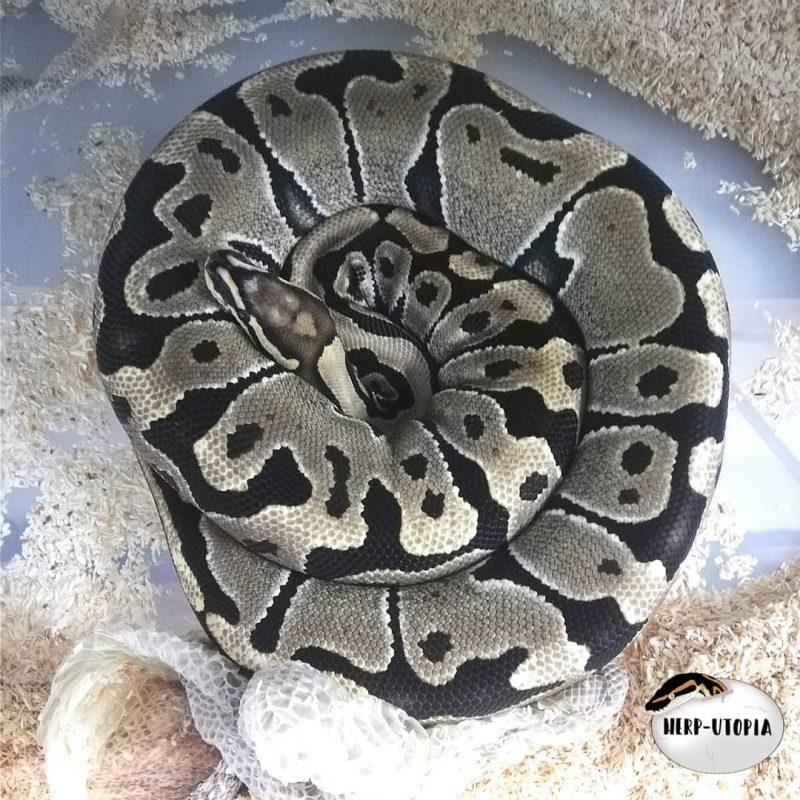
- Growth
Ball pythons lose their skin once they outgrow it. That’s why they shed so much when they are younger. Hatchling and immature ball pythons shed every 1-2 weeks, depending on their size. Because their top layer of skin cannot expand with them, they lose it.
Even as adults, ball pythons lose their skin, though not as frequently as when they were young.
- Healing
When a ball python is injured, it will also shed. When a ball python is damaged, shedding aids in the development of new skin.
When a snake is hurt, it heals from the inside out. The wound will grow less visible as each layer is lost, possibly leaving a scar.
- Protection
Ball pythons shed their skin to defend themselves from mites, worms, and other pests or pathogens.
Some mites and parasites will conceal and breed behind the scales of a ball python. The procedure of shedding can aid in the elimination of these parasites.
How Frequently do Ball Pythons Shed?
The pace at which ball pythons shed depends on a number of parameters, such as age, size, overall growth, and condition. They shed the most while they are young and developing swiftly. During the first year or two of their life, certain ball pythons may shed once per month.
Adult ball pythons shed significantly less regularly. Some may shed three or four times per year, whereas others shed just once or twice per year.
Conclusion
Ball pythons, like other snakes, shed their skin occasionally, which is something they’ll have to do for the rest of their lives. Because shedding is such an essential aspect of your ball python’s existence, it is important to understand the best techniques for assisting your ball python in the shed.
Just keep an eye on your snake to see if he’s beginning a shed phase and make any required husbandry changes to help him have problem-free shedding.
Ball pythons, luckily, aren’t very prone to shedding issues, and many caretakers will indeed be able to avoid them totally.
Read on to discover more about the various types of Ball Python.
Frequently Asked Questions
The outer layer of skin of your ball python accumulates dirt, dust, and particles over time. The scales might also be scraped by your snake’s typical activities. Both of these elements might cause your snake’s colors to fade over time.
When your ball python sheds, the filthy and injured scales are discarded, revealing the clean, new, vividly colored skin beneath. Newly shed ball pythons look their best as a result of this.
Ball pythons do not consume their excrement. Most reptiles that consume their shed do so for sustenance, but ball pythons do not. When they shed, they forget about it, and you may eliminate it from their enclosure right away.
The skin between your snake’s scales is quite elastic, but you won’t notice it unless your snake is feeding on enormous prey. Under normal conditions, your snake’s skin will be rather stiff around his body. The skin between your snake’s scales, on the other hand, can loosen and spread once shed.
There might be a few reasons why your ball python isn’t shedding at all. If your ball python is three years old or older, it may only shed a few times a year. However, young ball pythons shed more often as they develop.
It’s possible that your ball python isn’t shedding because you’re underfeeding it. Your ball python will not grow or shed if it is not acquiring weight.
About The Author


